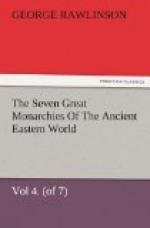The other lines of mound upon the east side of the river may either be Parthian works, or (possibly) they may be the remains of some of those lofty walls whereby, according to Diodorus, the greater palace was surrounded and defended. The fragments of them which remain are so placed that if the lines were produced they would include all the principal ruins on the left bank except the Babil tower. They may therefore be the old defences of the Eastern palace; though, if so, it is strange that they run in lines which are neither straight nor parallel to those of the buildings enclosed by them. The irregularity of these ramparts is certainly a very strong argument in favor of their having been the work of a people considerably more barbarous and ignorant than the Babylonians. [PLATE XIV.]
[Illustration: PLATE XIV.]
CHAPTER V. ARTS AND SCIENCES.
That the Babylonians were among the most ingenious of all the nations of antiquity, and had made considerable progress in the arts and sciences before their conquest by the Persians, is generally admitted. The classical writers commonly parallel them with the Egyptians; and though, from their habit of confusing Babylon with Assyria, it is not always quite certain that the inhabitants of the more southern country—the real Babylonians—are meant, still there is sufficient reason to believe that, in the estimation of the Greeks and Romans, the people of the lower Euphrates were regarded as at least equally advanced in civilization with those of the Nile valley and the Delta. The branches of knowledge wherein by general consent the Babylonians principally excelled were architecture and astronomy. Of their architectural works two at least were reckoned among the “Seven Wonders,” while others, not elevated to this exalted rank, were yet considered to be among the most curious and admirable of Oriental constructions. In astronomical science they were thought to have far excelled all other nations, and the first Greeks who made much progress in the subject confessed themselves the humble disciples of Babylonian teachers.
In the account, which it is proposed to give, in this place, of Babylonian art and science, so far as they are respectively known to us, the priority will be assigned to art, which is an earlier product of the human mind than science; and among the arts the first place will be given to architecture, as at once the most fundamental of all the fine arts, and the one in which the Babylonians attained their greatest excellence. It is as builders that the primitive Chaldaean people, the progenitors of the Babylonians, first appear before us in history; and it was on his buildings that the great king of the later Empire, Nebuchadnezzar, specially prided himself. When Herodotus visited Babylon he was struck chiefly by its extraordinary edifices; and it is the account which the Greek writers gave of these erections that has, more than anything else, procured for the Babylonians the fame that they possess and the position that they hold among the six or seven leading nations of the old world.




